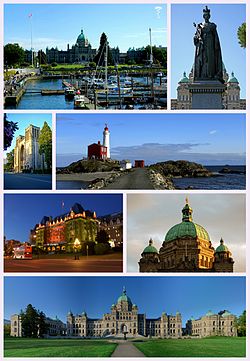Nouvelle-Rayenne
Nouvelle-Rayenne | |
|---|---|
Capital City | |
| Ville de Nouvelle-Rayenne | |
 Clockwise from top left: the Inner Docks, Statue of Queen Anne the Financer, Alexandre Lighthouse, dome of Parliament, full view of Parliament, the Imperial Hotel, and the City Cathedral. | |
| Nickname(s): The City of Maples, La Cap | |
| Motto(s): Semper Leber (Solarian) "Forever Free" | |
| Country | Cassier |
| Province | Monbec |
| Region | National Captial Region |
| Established | 1826 |
| Incorporated | 1855 |
| Amalgamated | 1 January 2001 |
| Government | |
| • Mayor | Jean Rouchelle |
| • City Council | Council of Nouvelle-Rayenne |
| Population (2016) | 651,006 |
| Website | www.nouvelle-rayenne.ca |
Nouvelle-Rayenne is the capital city of Cassier. It stands on the south bank of the Saint Marie River in the western portion of southern Monbec. Nouvelle-Rayenne borders Rideau, Breloux; the two form the core of the N-R-R census metropolitan area and the National Capital Region. As of 2016, Ottawa had a city population of 651,006 and a metropolitan population of 1,502,205 making it the fourth-largest city and the fifth-largest CMA in Cassier.
Founded in 1826, the city has evolved into the political centre of Cassier. Its original boundaries were expanded through numerous annexations and were ultimately replaced by a new city incorporation and amalgamation in 2001 which significantly increased its land area. The city name Nouvelle-Rayenne was chosen in reference to the city of Rayenne in Gaullica.
Nouvelle-Rayenne has the most educated population among Cassien cities and is home to a number of post-secondary, research, and cultural institutions, including the National Arts Centre, the National Gallery, and numerous national museums. Nouvelle-Rayenne has among the highest standards of living in the nation and the lowest rate of unemployment.